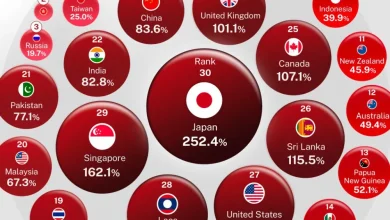Visual Insights: The State of Trade Around the World

Global trade in 2024 is evolving through digital transformation, sustainability, and economic shifts. Resilient supply chains are now prioritized, with businesses investing in automation and AI to mitigate risks from geopolitical tensions and natural disruptions.
Digital trade continues to grow, enabling small businesses to access international markets, while major trade agreements like RCEP foster regional cooperation.
Sustainability is integral, with green trade practices gaining traction amid climate-focused policies. However, challenges such as inflation and geopolitical instability persist, impacting trade costs. .
1. Trade expanded in two waves
Trade has expanded in two major historical waves, each driven by transformative global forces. Here’s a breakdown of these waves:
First Wave: Industrial Revolution and Colonial Expansion (19th Century)
1. Industrial Advancements: Mass manufacturing was introduced during the Industrial Revolution in the 18th and 19th centuries, which increased output and decreased costs. Production capacity were increased by inventions like the steam engine, railroads, and mechanized textiles.
2. Transportation Innovations: The development of railroads and steamships significantly reduced the time and expense of transporting products between areas, enabling the mass export of produced goods.
3. Colonial Markets and Resources: When European countries founded colonies, they served as markets for manufactured goods and as sources of raw materials like cotton, rubber, and minerals.
Second Wave: Post-WWII Globalization (Mid-20th Century Onward)
- Constitutional Foundations: To develop rules-based international trade systems, organizations such as the General Agreement on Tariffs and Trade (GATT) and later the World Trade Organization (WTO) were founded following World War.
- Developments in Communication and Transportation: The effectiveness and speed of global trade were improved by innovations like container shipping, jet air travel, and telephones.
- Growth of Multinational Corporations (MNCs): Businesses started to conduct business internationally, establishing intricate global supply chains and outsourcing production to areas with cheaper labor costs.

2. What are the key trends in global trade?
Global trade in 2024 is shaped by key trends such as digital transformation, supply chain resilience, and sustainability. The rapid growth of e-commerce and digital platforms is enabling businesses, especially small and medium-sized enterprises (SMEs), to access international markets more efficiently.
In response to recent global disruptions, companies are prioritizing supply chain resilience through automation, nearshoring, and artificial intelligence. Sustainability is a critical focus, with green trade practices and climate-focused policies gaining momentum.
Meanwhile, new trade agreements, such as the Regional Comprehensive Economic Partnership (RCEP), are reshaping trade flows, particularly in Asia. However, inflation and geopolitical tensions remain ongoing challenges, influencing costs and trade strategies.
3. How do geopolitical tensions affect global trade?
Global trade can be seriously disrupted by geopolitical crises.
1. Trade restrictions such as quotas and tariffs can impede the movement of products between countries. 2. Global supply chains can be upset by tensions, which can cause shortages, price hikes, and business uncertainty.
3 . Political unpredictability and instability might also discourage foreign direct investment, which would hinder economic growth and limit trade prospects.
4. In an effort to reduce risks, nations may try to diversify their trading partners, which could have an impact on current trade partnerships.
5. In addition, regional trade blocs may be formed as a result of geopolitical disputes, which could exclude some nations and restrict international trade.
6. These elements have the potential to make the global trading environment more complicated and fragmented, which will affect consumers, firms, and economies all across the world.
Conclusion:
Global trade in 2024 is at a transformative juncture, shaped by digital advancements, evolving geopolitical landscapes, and a growing focus on sustainability. Digital technologies like automation, AI, and blockchain are making global trade faster and more efficient, while e-commerce continues to break down traditional barriers to market access. At the same time, geopolitical challenges and inflationary pressures create both obstacles and opportunities, pushing businesses to prioritize resilience and adaptability. Sustainability initiatives are also becoming integral, reflecting the increasing importance of eco-conscious trade practices. Navigating this complex environment requires innovation, agility, and a commitment to sustainable growth.
faqs:
1. What are the current trends shaping global trade?
In 2024, supply chain resilience, sustainability, and digital transformation will all have an impact on global trade. Green trade practices are becoming more and more important, supply chains are becoming stronger through automation and nearshoring, and e-commerce is growing quickly.
2. How has technology impacted international trade?
Trade has been transformed by technology, such as blockchain, AI, and automation, which have increased productivity, cut expenses, and made real-time tracking possible. Additionally, digital trade platforms are making it easier for small enterprises to join international markets.
3. How can we visualize global trade trends ?
Supply chain diagrams, bar and line charts, heat maps, and interactive trade flow maps can all be used to visualize global trade trends. These tools track trade volumes, display regions with the most active trade, and show the flow of products between nations. For example, supply chain diagrams show how goods move through international networks, while heat maps utilize color gradients to show the intensity of commerce across various regions. Real-time data is also provided by dynamic dashboards and infographics, which assist companies and decision-makers in keeping an eye on changes in trade trends, new markets, and the effects of world events. Complex trade data is easier to understand and use thanks to these visuals.



